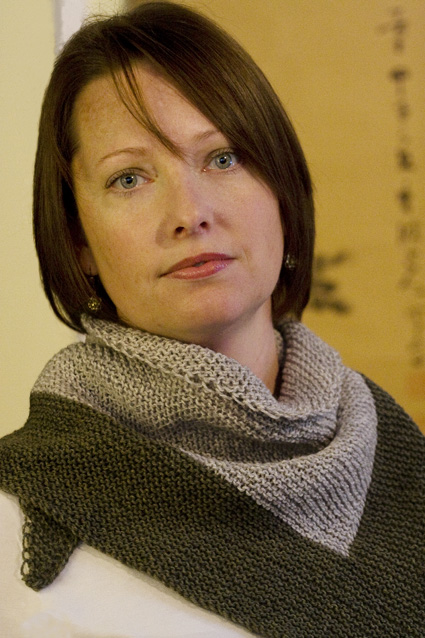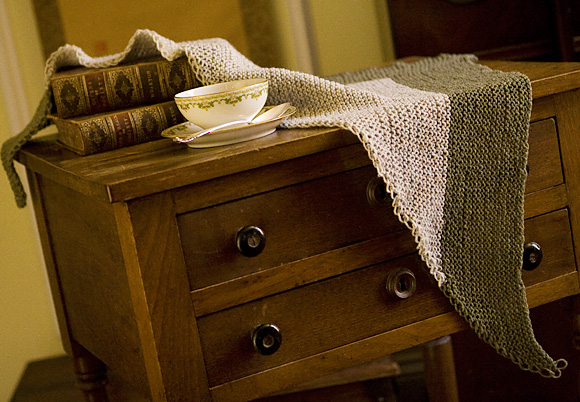

|
|
|
|
When I first became a knitter, it was in part because my heart’s desire was unavailable at the time from any Boston department store: a pure wool scarf, not less than seven feet long. That was the practical reason I learned to cast on. The less practical, but equally urgent, reason: knitting was, in those dark days, such a rare pastime that saying you knit was akin to saying you preferred to make dinner reservations via telegraph. It wasn’t merely quaint, it was violently anachronistic. It was freakish. It was for me. Once admitted to the asylum, I began loitering around the locked wing that housed the antique knitting patterns. Through jagged bars of nineteenth-century type, under labels straight from Alice in Wonderland (muffatee? is that a sub-species of Jabberwock?), they appeared more fantastically, exotically interesting than yet another pattern for a cabled hat. But time spent among them led me to realize that what had seemed exotic was often only a trick of perspective. Names change and details evolve, yet a close scrutiny of antique patterns often reveals how little knitting–and knitters–have changed in eighteen decades. Look closely at a muffatee and you’ll discover not a monster, but a fingerless mitt. It’s easy to imagine that nineteenth-century knitters were a species far removed from our own. Romantic rumors have got about that they were infinitely more patient than we, and smarter, and faster; and that they knit everything from underwear to kitchen curtains with cobweb yarn on size 0000000000000000000 needles. This is something of an exaggeration. It is true that Victorian gauges often include slots and holes for needles no thicker than a gnat’s eyelash. It is true that patterns from the time more frequently call for yarns at the DK/fingering end of the curve than they do for bulky or giant wools. But such is the case in our time as well. The median may have shifted towards worsted, yet the popularity of the extremely thick and thin continues to wax and wane with fashion. And I can’t believe – though I admit this is pure speculation – that Victorian knitters were any less inclined than we to substitute yarns, adapt (or ignore) pattern instructions, and select projects based upon the amount of time or the amount of wool they had available. Then as now, the majority knit for pleasure, not survival; and the pattern books suggest that they favored the same sorts of projects we do: stuff for the baby, stuff for the house, stuff for charity or gift giving, and stuff for themselves. The “Summer Neckerchief” included by Jane Gaugain in her Miniature Knitting, Netting and Crochet Book*(1843) is ancient by knitting pattern standards, but to modern eyes it looks fresh as new paint. It is the smaller, finer-gauged cousin of another project in the same volume: a full-sized shawl dubbed “Chinee” [sic] by Mrs Gaugain in a probable nod to the taste for Orientalism then rampant in Europe, and possibly also due the shawl’s very vague resemblance to plain, white silk models imported from China. Mrs. Gaugain – who ran a successful Edinburgh haberdashery with her husband – was among the first (possibly the first) purveyors of hand-knitting supplies to recognize that her customers would buy more yarn if they were provided with a profusion of tempting patterns. She had a genius for giving knitters what they wanted; this little triangle is no exception. It is fun to knit, easily made in other sizes or with other yarns, simple enough to work in chatty company and versatile enough to be worn with any number of different outfits. Good selling points then, no less so now. An 1840s knitter would likely have worn it with the point in back, and the ends either tied, pinned or tucked into her bosom. Turn it around, and wear it with the point at the front in the current, approved hipster fashion–and see if this bit of early Victorian frippery does not, against all odds, become a staple of your twenty-first century wardrobe. *It’s the book that’s tiny, not the projects. |
|
 |
 |
translated by Franklin Habit from Mrs
Gaugain’s Miniature Knitting, Netting and Crochet
Book (c. 1843)
|
 |
| SIZE |
| One |
|
FINISHED MEASUREMENTS |
Width: 40 inches |
|
MATERIALS Notions |
| GAUGE |
20 sts/40 rows = 4" in garter stitch |
|
PATTERN NOTES |
This project is worked flat, in one piece, in garter stitch. Instructions for the Shawl Variation follow the Neckerchief pattern. Slipped sts: Slip all slipped sts purlwise, with yarn held to front of work. Bring yarn between needles to back of work before working next st. Yarnover at beginning of row: Bring the working yarn from front to back over the right needle before knitting the next stitch. This is the method of increase employed at the long (top) edge of the triangle, and it creates a very pretty row of loops at the edge. Joining a new color: Mrs. Gaugain calls for the knitter to “tie on” a new color when it is introduced at the beginning of a RS row. I prefer, instead, to thread the strand of the new color onto a yarn needle and weave it lightly into the WS of the fabric near the edge of the work, so that the first maneuver of the RS row (a yarnover – see above) can be performed. This initial weaving can be neatened up during the finishing process. Changing colors within a row: When switching from one color to the next on a RS row, drop the color you have been knitting with, and bring the yarn for the next color up under the yarn of the previous color before you continue knitting. This will twist the strands around each other, preventing a gap from forming where the colors meet. On WS rows, bring the old color between the needles to the front of the work, bring the yarn for the next color up under the yarn of the previous color and between the needles to the back of the work. (Yes, it’s intarsia. But I won’t tell anybody if you won’t.) Historic colors: The original pattern suggests pink or blue for the border, and white for the center. |
|
DIRECTIONS |

Using CC, CO 3 sts. After you have worked the first few rows, use safety pin or split ring marker to mark RS of work. Row 1 [WS]: Sl 1, k2. Begin Center and Continue Right Border: Work Left Border: |
| Finishing |
| Gently wet block, taking care to keep edges straight and short sides equal in length. When dry, weave in ends on WS. |
| Shawl variation |
This pattern is the smaller cousin of Mrs. Gaugain’s “Chinee [sic] Wrapping Shawl” from the same volume. To work the shawl, use a yarn of the same weight, but needles two sizes larger (gauge will be very loose). Work pattern as written, but continue working second section (center and right border) until the piece measures 1.25yd along shaped edge. Finish by working the left border as written. For the shawl, Mrs. Gaugain suggests a brown border with a pink or blue center. |
|
|
| ABOUT THE DESIGNER |
 Franklin spends so much time on the road these days, teaching and speaking about knitting, that American Airlines has just sent him a highly suggestive mix tape. |
| Pattern & images © 2011. Franklin Habit. |